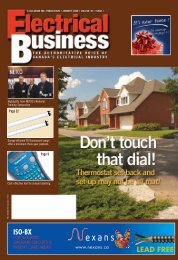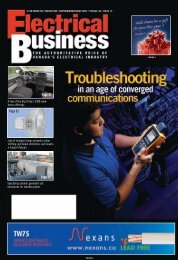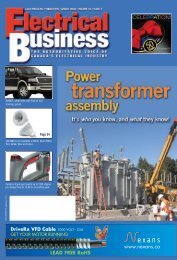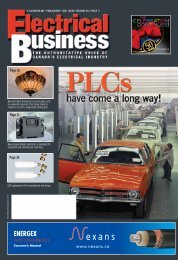Download - Electrical Business Magazine
Download - Electrical Business Magazine
Download - Electrical Business Magazine
Create successful ePaper yourself
Turn your PDF publications into a flip-book with our unique Google optimized e-Paper software.
By Dave SmithMIND YOUR SAFETYMeeting the new CSA Z462 standardThe final draft of CSA’s much-anticipated standard onworkplace electrical safety, Z462, is complete; it willbe available in January, though there’s still a greatlack of understanding surrounding this standard.First, a little background: the Canadian StandardsAssociation creates standards for Canadians. Havingthis national body for writing standards meansindividual provinces/territories need not have theirown standards-writing bodies. CSA writes standardswith input from all Canadians, then makes thempublicly available on a cost recovery basis.CSA has no legislative powers; its standards arevoluntary. Provinces and territories (and companies)choose whether they wish to adopt them. For instance,it has been standard practice for decades that eachjurisdiction adopt the Canadian <strong>Electrical</strong> Code(C22.1-06, Part I, Safety Standard for <strong>Electrical</strong> Installations).Other standards—especially new ones—arenot automatically adopted.seems simple enough until you learn thatCategory 0 requires cotton clothing—nopolyester blends, which are outside thestandard. For example:A worker goes to reset a breaker that hastripped due to the poor use of a chop saw,and the panel flashes during reset.If his overalls ignite, he’s off to the burncentre; you’re outside the standard, andauthorities will conclude you haven’t met thespecific duty clause. Good luck in court.And even if your jurisdiction does notyet have a specific duty clause relatingto arc flash or flashover, it is guaranteedto have a general duty clause, which useswording like “The employer shall protectworkers from all recognized hazards”. Arcflash and flashover are now very well-recognizedhazards and, in the example above,you would still find yourself in court.An electrician is voltage testing a 600V disconnect.He must be protected to HRC 2*.If you do not know what this means, you’reoutside the standard. You’d better hope ameter lead does not slip off a lug, or elseyou’ll find yourself in court again.The bottom line is you have to protectyour workers, and the only way to protectthem from arc flash or flashover is byadopting CSA Z462 as your minimumstandard. It is the best risk managementyou’ll ever employ to protect your electricaland other workers. Should you choose notto adopt it, then you may as well cancelthat fire insurance you have on yourhouse... you’re less likely to experience ahouse fire than an industrial accident.Until next time, be ready, be careful andbe safe.Dave Smith is president of Canada TrainingGroup and has been providing consulting servicesto industry since 1980. You’ll find storieslike this one at www.canada-training-group.ca;feel free to use this information to support yourown safety program. Dave can be reached atdavesmith@canada-training-group.ca.Standard on Workplace <strong>Electrical</strong>Safety seeks Adoption!Z462 is a new standard, meaning it will take years (ifever) before jurisdictions begin adopting it. Herein laythe problem: many people believe that, unless Z462is officially adopted, no one has to follow it.This is a major misconception: in numerousCanadian jurisdictions, safety legislation statesemployers must protect their workers from arc flashor flashover. The wording may change, but the legislativeintent does not. This is referred to as a specificduty clause. When your company operates in a jurisdictionwhere this wording is found in the legislation,then Z462 is not optional. The final defence for protectingyour workers from arc flash or flashover is PPE(personal protective equipment), and the only way todetermine appropriate PPE is by following Z462.There are two methods for determining PPE withinZ462. The first, Clause 4.3.3.3.2, describes “Method1: Selection based on incident energy analysis”, whichis also known as conducting an arc flash hazardanalysis. This has at least six parts to it:1. Conduct a short-circuit study2. Conduct a co-ordination study3. Take the results from these and conduct the arcflash hazard analysis4. Put labels on all of your equipment describingthe arc flash hazard at that equipment5. Purchase the PPE that will protect yourworkers at that equipment6. Train your workers to understand the labelsand correct PPE use.Looks simple, right? Wrong. $10,000 doesn’t go veryfar, and one northern mine is looking at a $2.5-millioninvestment. A major city transit system figures it mighttake about five years to complete its study.A less expensive—though not as precise—method isto have your workers follow the ‘Task Tables’. Clause4.3.3.3.3 describes “Method 2: Selection based onhazard/risk categories”, which refers you to Clause4.3.7.3.9 “Selection of personal protective equipmentfor various tasks”.These tasks are listed in Table 4 “Hazard/riskcategory classifications and use of rubber insulatinggloves and insulated and insulating hand tools”.Further complicating the mix is that the Task Tablesare limited to systems with short-circuit and protectivedevice parameters that are known to be under a certainlimit. When the system is beyond that limit, Clause4.3.7.3.9 requires an incident energy analysis.Until then, Table 4 lists common tasks performedon electrical equipment. For example, operating a120V, 15A breaker is a Hazard/Risk Category 0 ThisReduce cost and downtime whileincreasing safety and flexibilitySquare D ® Brand MD50Motor Disconnect SwitchThe Square D ® brand has been an industry leader in safetyswitches for over 100 years and is recognized as the marketleader in quality, durability and product development. Thelatest addition to our industry-leading line of safety switchesis the MD50 motor disconnect.The MD50 motor disconnect is a pin and sleeve interlockedreceptacle switch “Suitable As Motor Disconnect” in onecompact type 4X enclosure. It is offered in 20A, 30A, 60A and100A units compatible with IEC 60309-2 plug configurations.The MD50 switch with a receptacle interlock allows motordriven equipment and motors to be moved into and out of agiven space when necessary. Plus, a key safety feature is thatthe interlock switch design requires an operator to turn off theload before removing the machine plug from the receptacle.Make the most of your energy SMwww.schneider-electric.caSchneider_1_EB_Nov08.indd 111/6/08 1:54:19 PMwww. mag.com • NOVEMBER/DECEMBER 2008 • 19
















